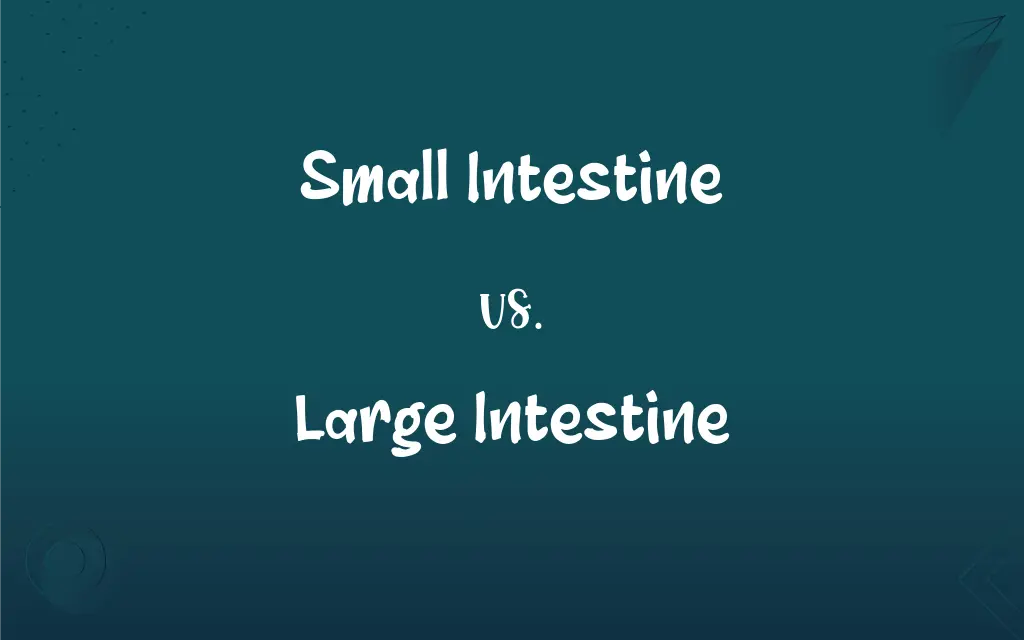Small Intestine vs. Large Intestine: What's the Difference?
Edited by Aimie Carlson || By Harlon Moss || Updated on October 30, 2023
The small intestine absorbs nutrients from digested food, while the large intestine absorbs water and forms feces.

Key Differences
The small intestine is a vital part of the digestive system, responsible primarily for the absorption of nutrients from the food we consume. It is longer and narrower than the large intestine. In contrast, the large intestine, though shorter and wider, plays a pivotal role in reabsorbing water from the digested food, leaving behind waste to be excreted.
Both the small intestine and large intestine are integral to our digestive process. The small intestine can be further divided into three parts: the duodenum, jejunum, and ileum. As food moves through these sections, various enzymes break it down, allowing the body to absorb essential nutrients. The large intestine, on the other hand, has distinct sections like the cecum, colon, and rectum. Its main function is to remove water, forming a more solid waste that the body can expel.
While they both interact with digested food, the small intestine and large intestine handle different aspects of digestion. The small intestine ensures that the body absorbs vital nutrients like vitamins, minerals, and other necessary compounds. Meanwhile, the large intestine focuses on preventing dehydration by reabsorbing water and creating feces.
Though they have different functions, the small intestine and large intestine work together in harmony. After the small intestine extracts necessary nutrients, the remaining undigested food passes to the large intestine. There, water is reclaimed, and bacteria in the large intestine help break down remaining material, aiding in the formation of feces.
In summary, both the small intestine and large intestine are indispensable parts of our digestive system. The small intestine focuses on nutrient absorption, ensuring our body gets the necessary building blocks for growth and energy. Conversely, the large intestine plays a crucial role in water reabsorption and waste formation, maintaining our body's water balance and facilitating waste excretion.
ADVERTISEMENT
Comparison Chart
Primary Function
Nutrient absorption from digested food.
Water absorption and feces formation.
Length
Longer, typically around 20 feet in adults.
Shorter, typically around 5 feet in adults.
Diameter
Narrower.
Wider.
Subdivisions
Duodenum, jejunum, ileum.
Cecum, colon, rectum.
Interaction with Food
Breaks down and absorbs nutrients.
Reabsorbs water and consolidates undigested food into feces.
ADVERTISEMENT
Small Intestine and Large Intestine Definitions
Small Intestine
Transports digested food to the large intestine.
After nutrient absorption, the small intestine moves remaining material to the large intestine.
Large Intestine
Forms and expels feces.
Waste material solidifies in the large intestine before excretion.
Small Intestine
Longer and narrower part of the digestive tract.
Despite its length, the small intestine fits compactly in the abdominal cavity.
Large Intestine
Shorter but wider than the small intestine.
The large intestine's girth is evident when compared to the small intestine.
Small Intestine
Divided into duodenum, jejunum, ileum.
Enzymes in the small intestine aid in breaking down food.
Large Intestine
Ends in the rectum and anus.
The large intestine concludes the digestive process by expelling waste.
Small Intestine
Interacts with pancreatic and bile enzymes.
The small intestine receives enzymes that help digest fats and proteins.
Large Intestine
Primary site for water reabsorption.
The large intestine ensures the body retains essential water.
Small Intestine
Primary site of nutrient absorption.
The digested food in the small intestine allows for nutrient uptake.
Large Intestine
Contains beneficial bacteria.
The large intestine hosts bacteria that aid in digestion and vitamin production.
FAQs
Are there beneficial bacteria in the large intestine?
Yes, the large intestine contains bacteria aiding in digestion and vitamin production.
How is food processed in the small intestine?
In the small intestine, food is broken down, and essential nutrients are absorbed.
Where does undigested food go after the small intestine?
It passes to the large intestine for water reabsorption and waste formation.
Which is longer: the small intestine or the large intestine?
The small intestine is longer, often around 20 feet in adults.
Which part of the intestine is responsible for stool formation?
The large intestine is responsible for forming and expelling feces.
Can issues in the large intestine lead to dehydration?
Yes, if the large intestine doesn't effectively reabsorb water, it can cause dehydration.
Is the pH level different between the small intestine and large intestine?
Yes, the small intestine is typically more alkaline, while the large intestine is more acidic.
Why is nutrient absorption vital in the small intestine?
It ensures the body receives essential vitamins, minerals, and energy sources from the food consumed.
What role does the large intestine play in digestion?
The large intestine reabsorbs water and forms feces for excretion.
How does the small intestine aid in digestion?
The small intestine interacts with pancreatic and bile enzymes to break down food.
Is the diameter of the small intestine bigger than the large intestine?
No, the small intestine is narrower compared to the wider large intestine.
What can affect the health of the small intestine?
Factors like infections, diseases, and dietary habits can impact the small intestine's health.
How does the large intestine maintain water balance?
By reabsorbing water from the remaining undigested food, the large intestine maintains the body's water balance.
What's the primary function of the small intestine?
The small intestine primarily absorbs nutrients from digested food.
Are there any enzymes produced in the large intestine?
The large intestine doesn't produce digestive enzymes but hosts bacteria that aid in digestion.
How are the small intestine and large intestine connected?
They're connected at the ileocecal valve, where the ileum of the small intestine meets the cecum of the large intestine.
What protects the inner lining of the small intestine?
Villi and microvilli in the small intestine increase surface area and aid in nutrient absorption.
Where does waste get solidified in the digestive process?
Waste gets consolidated in the large intestine, leading to feces formation.
What sections make up the small intestine?
The small intestine consists of the duodenum, jejunum, and ileum.
Why is the small intestine coiled?
The coiling increases surface area for efficient nutrient absorption.
About Author
Written by
Harlon MossHarlon is a seasoned quality moderator and accomplished content writer for Difference Wiki. An alumnus of the prestigious University of California, he earned his degree in Computer Science. Leveraging his academic background, Harlon brings a meticulous and informed perspective to his work, ensuring content accuracy and excellence.
Edited by
Aimie CarlsonAimie Carlson, holding a master's degree in English literature, is a fervent English language enthusiast. She lends her writing talents to Difference Wiki, a prominent website that specializes in comparisons, offering readers insightful analyses that both captivate and inform.































































